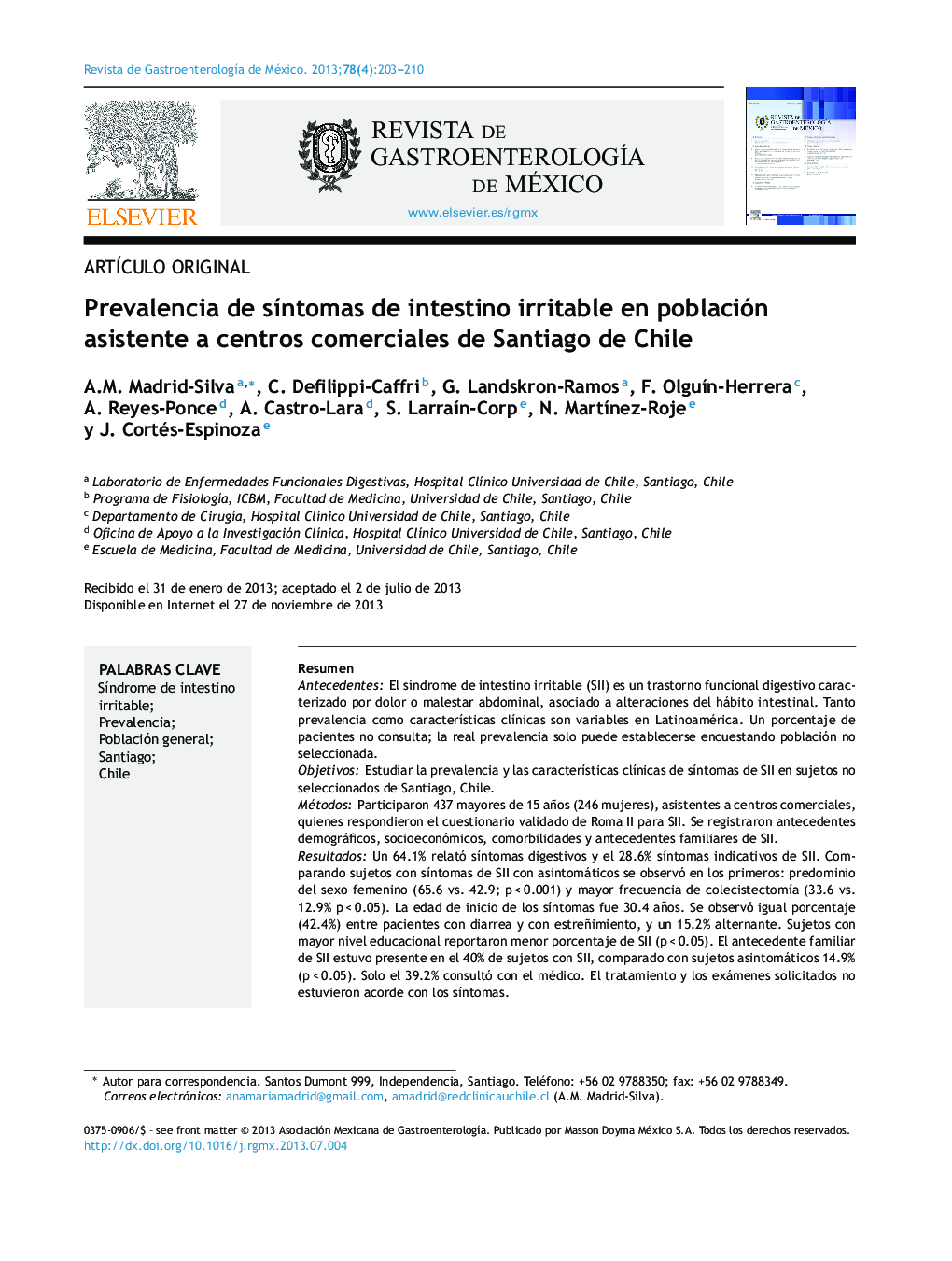| Article ID | Journal | Published Year | Pages | File Type |
|---|---|---|---|---|
| 3318811 | Revista de Gastroenterología de México | 2013 | 8 Pages |
ResumenAntecedentesEl síndrome de intestino irritable (SII) es un trastorno funcional digestivo caracterizado por dolor o malestar abdominal, asociado a alteraciones del hábito intestinal. Tanto prevalencia como características clínicas son variables en Latinoamérica. Un porcentaje de pacientes no consulta; la real prevalencia solo puede establecerse encuestando población no seleccionada.ObjetivosEstudiar la prevalencia y las características clínicas de síntomas de SII en sujetos no seleccionados de Santiago, Chile.MétodosParticiparon 437 mayores de 15 años (246 mujeres), asistentes a centros comerciales, quienes respondieron el cuestionario validado de Roma II para SII. Se registraron antecedentes demográficos, socioeconómicos, comorbilidades y antecedentes familiares de SII.ResultadosUn 64.1% relató síntomas digestivos y el 28.6% síntomas indicativos de SII. Comparando sujetos con síntomas de SII con asintomáticos se observó en los primeros: predominio del sexo femenino (65.6 vs. 42.9; p < 0.001) y mayor frecuencia de colecistectomía (33.6 vs. 12.9% p < 0.05). La edad de inicio de los síntomas fue 30.4 años. Se observó igual porcentaje (42.4%) entre pacientes con diarrea y con estreñimiento, y un 15.2% alternante. Sujetos con mayor nivel educacional reportaron menor porcentaje de SII (p < 0.05). El antecedente familiar de SII estuvo presente en el 40% de sujetos con SII, comparado con sujetos asintomáticos 14.9% (p < 0.05). Solo el 39.2% consultó con el médico. El tratamiento y los exámenes solicitados no estuvieron acorde con los síntomas.ConclusiónLa prevalencia de síntomas de SII en la población estudiada es una de las más altas descritas, por lo cual los equipos de salud debieran tener los conocimientos y destrezas adecuados para su manejo
BackgroundIrritable bowel syndrome (IBS) is a functional gastrointestinal disorder characterized by abdominal pain or discomfort that is associated with altered bowel habit. Both its prevalence and clinical characteristics vary throughout Latin America. A percentage of patients does not seek medical attention, therefore a reliable prevalence figure can only be established by interviewing non-selected populations.AimsTo study the prevalence and clinical characteristics of IBS symptoms in non-selected subjects in Santiago, Chile.MethodsA total of 437 shopping mall visitors above the age of 15 years (246 women) participated in the study by answering the Rome II validated questionnaire for IBS. The demographic and socioeconomic backgrounds, comorbidities, and a family history of IBS were registered.ResultsA total of 64.1% subjects reported having gastrointestinal symptoms and 28.6% had symptoms suggestive of IBS. When the subjects with IBS symptoms were compared with the asymptomatic individuals, a predominance of women (65.6 vs. 42.9, P<.001) and a greater cholecystectomy frequency (33.6 vs. 12.9% P<.05) were observed in the former. The age of symptom onset was 30.4 years. An equal percentage of subjects (42.4%) presented with diarrhea and constipation and 15.2% presented with alternating IBS. Participants with a higher educational level reported a lower percentage of IBS (P<.05). A family history of the disease was present in 40% of the subjects with IBS, compared with 14.9% in the asymptomatic individuals (P<.05). Only 39.2% of the subjects had seen a physician for their symptoms and the treatment and tests ordered were inappropriate.ConclusionThe prevalence of IBS symptoms in the population studied is one of the highest described. Therefore, health teams should have the necessary knowledge and skill required for its management.
